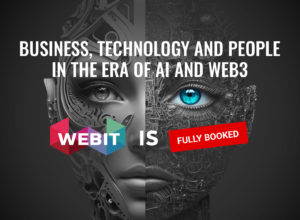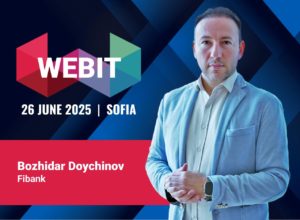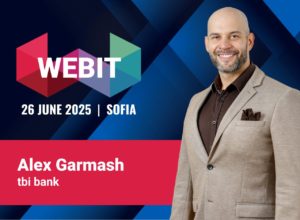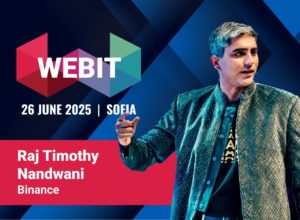Posts by WEBIT_Admin
We are at FULL CAPACITY for Webit 2025 – Web3 &...
📍 Where: National Palace of Culture (NDK), Sofia
📅 When: June 26
🕗 Registration starts tomorrow at 8:00 AM (EET)
🌍 Join top global leaders in business, tech, policy, media, and startups as we dive into how AI and Web3 are transforming industries — from healthcare and finance to green innovation and beyond.
💡 Expect bold ideas, breakthrough innovations, and the people shaping the future.
⚠️ We’re fully booked and beyond excited! If you’ve secured your spot — be there early!
Let’s make history at #Webit2025. We’re expecting you. 🙌
We’re thrilled to welcome Bozhidar Doychinov, First Investment Bank, to the...
Bozhidar is a driving force behind Fibank’s digital innovation—blending cutting-edge technology with real-world usability to redefine the customer experience. He has led the transformation of the My Fibank mobile app into a go-to banking platform, introducing instant transfers, peer-to-peer payments, and even enabling users to trade stocks and ETFs directly from their phones. 📊💡
With a career dedicated to pushing the boundaries of digital banking, Bozhidar brings sharp insight into how financial institutions can thrive in a tech-driven world, while always keeping the user front and centre.
Get ready to be inspired by a leader helping shape the future of finance, one digital breakthrough at a time. 🌐💼
All participants were carefully selected and personally invited leaders from industries they represent, and now fewer than 20 public tickets for public sale are available before we close registration.
👉 Book Tickets now:
https://www.webit.org/2025/sofia/tickets.php
#Webit #Webit2025 #Innovation #Webitchangemakers
We’re thrilled to welcome Angelina Borisova to the #Webit2025 Main Stage!
As Founder of Anagami Digital Accounting and Autsorsa | HR & BPO Solutions, Angelina is building smarter, scalable businesses through strategic accounting and global talent solutions. 🚀
At Anagami, she leads a team delivering cross-border tax, finance, and compliance, now expanding into Dubai and the UAE to support globally minded companies.
With Autsorsa, she helps organisations tap into top talent across Europe, the UK, and the Middle East—making remote hiring fast, compliant, and effective. 🌐💼
All participants were carefully selected and personally invited leaders from industries they represent, and now fewer than 20 public tickets for public sale are available before we close registration.
👉 Book Tickets now:
https://www.webit.org/2025/sofia/tickets.php
#Webit #Webit2025 #Innovation #Webitchangemakers
We’re excited to announce Spas Ivanov, BaseLine CyberSecurity, as a featured...
With nearly two decades of experience guarding digital frontiers, Spas is a trusted name in both national and international security projects.
He leads Bulgaria’s first fully operational Security Operations Centre (SOC) — a major milestone for the country’s cyber defence landscape 🔒🌐
As a certified ISO 27001 lead auditor and advisor to countless organisations, Spas brings hands-on expertise in helping businesses stay ahead of evolving threats and compliance standards. His leadership is shaping how the public and private sectors approach cyber resilience.
All participants were carefully selected and personally invited leaders from industries they represent, and now fewer than 20 public tickets for public sale are available before we close registration.
👉 Book Tickets now: https://www.webit.org/2025/sofia/tickets.php
#Webit #Webit2025 #Innovation #Webitchangemakers
We’re thrilled to welcome Serkan Girgin, Google to #Webit2025!
With two decades of experience across #B2C and #B2B marketing, Serkan Girgin brings a sharp perspective on how tech transforms business.
Before joining Google in 2012, Serkan held senior roles at global powerhouses like Pepsi, Danone, and Lipton. Now, he leads Google’s marketing efforts in Türkiye and has previously overseen Ads Marketing across the EMEA region.
Now, Serkan is exploring the next frontier: how #AI-powered platforms like #Gemini transform from simple tools into true teammates for marketers and creatives.
🎟 This is an exclusive, invitation-only event, with only 50 public tickets available.
If you want to be part of shaping the future, this is your moment.
https://www.webit.org/2025/sofia/tickets.php
We’re delighted to welcome Alex Garmash, tbi bank, to Webit 2025...
With over two decades of experience spanning global consulting firms, C-suite roles, and cross-industry transformations, Alex is a true strategist at the intersection of finance, innovation, and operational excellence.
At tbi bank, he’s spearheading growth and partnerships across Bulgaria, Romania, and Greece — helping to reshape the region’s merchant and fintech landscape.
From McKinsey and Alvarez & Marsal to the frontlines of banking innovation, Alex brings a rare blend of insight and execution.
His academic credentials — from London Business School to Harvard, Wharton, and Oxford — reflect a lifelong commitment to mastering complex global systems and driving impact where it matters most.
🎟 This is an exclusive, invitation-only event, with only 50 public tickets available. If you want to be part of shaping the future, this is your moment.
https://www.webit.org/2025/sofia/tickets.php
#Webit2025 #FintechLeadership #DigitalBanking #TBIbank #TransformationExpert #BusinessGrowth #WebitSpeakers #FutureOfFinance
We’re excited to welcome Raj Timothy Nandwani, Binance, to Webit 2025...
Raj is a powerhouse in the crypto and digital asset space, driving hashtag#Web3's global expansion through strategic partnerships, high-impact dealmaking, and bold business development.
With over a decade of experience shaping #fintech and #blockchain ecosystems, he’s helping to transform how the world interacts with digital finance.
At Binance, Raj leads initiatives that push the boundaries of innovation, from advisory and investment strategies to capacity building and thematic research. His work is redefining the future of financial infrastructure and decentralised technologies.
🔥 At Webit, Raj will bring deep insights into the evolution of hashtag#Web3 and the real-world impact of blockchain adoption.
🎟 This is an exclusive, invitation-only event, with only 50 public tickets available. If you want to be part of shaping the future, this is your moment.
👉 https://lnkd.in/dkRHJ9mn
#Webit2025 CryptoLeadership #Web3 #BlockchainInnovation #FintechFuture #Binance#DigitalAssets #TechTransformation
We’re excited to announce Martin Bakardzhiev, Visa Consulting Services, as a...
At the forefront of digital payments, Martin leads Visa’s consulting initiatives in Bulgaria while driving #cybersecurity and fraud prevention across Central and Eastern Europe.
With a background in top-tier companies like PwC and Crypto. com, and academic roots stretching from Lancaster to Groningen (with a PhD in progress), Martin blends strategic insight, financial acumen, and deep expertise in digital risk.
Martin joins a stellar lineup of speakers at Webit — and more are coming soon!
🎟️ This is an exclusive, invitation-only event, with only 50 public tickets available. If you want to be part of shaping the future, this is your moment.
https://www.webit.org/2025/sofia/tickets.php
#Webit2025 #Fintech #Cybersecurity #DigitalPayments #Visa #FinanceInnovation #WebitSpeakers
We’re excited to welcome Brent Summers, Qualcomm Technologies to the stage...
We’re excited to welcome Brent Summers, Qualcomm Technologies to the stage at #Webit2025 in Sofia!
Brent brings a unique combination of UX expertise, #B2B marketing know-how, and a forward-thinking approach to #AI, helping enterprises embrace Account-Based Marketing (ABM) and #GenerativeAI to fuel scalable growth.
🎟️ This is an exclusive, invitation-only event, with only 50 public tickets available. If you want to be where the future is shaped, this is your moment:
👉 https://webit.org/2025/sofia/
#Webit2025 #AIinMarketing #B2BInnovation #GTMLeadership #AccountBasedMarketing #GenerativeAI #Qualcomm #TechForGrowth #DigitalTransformation








